It have been two weeks since I´ve published the last article: Sorry for letting you guys wait such a long time! Unfortunately I wasn´t out sailing, this year – like last year I fear – is quite busy with many deliveries and handovers to new owners. Last week I actually attended the annual dealer´s meeting for Beneteau, which is a must attend occasion for me of course, and so it´s amazing to see 14 days zipping by before your eyes, no spare time (which is writing this magazine for me) at all. Anyway, here I am back in Germany with a lot of nice stories – let´s start with this one …
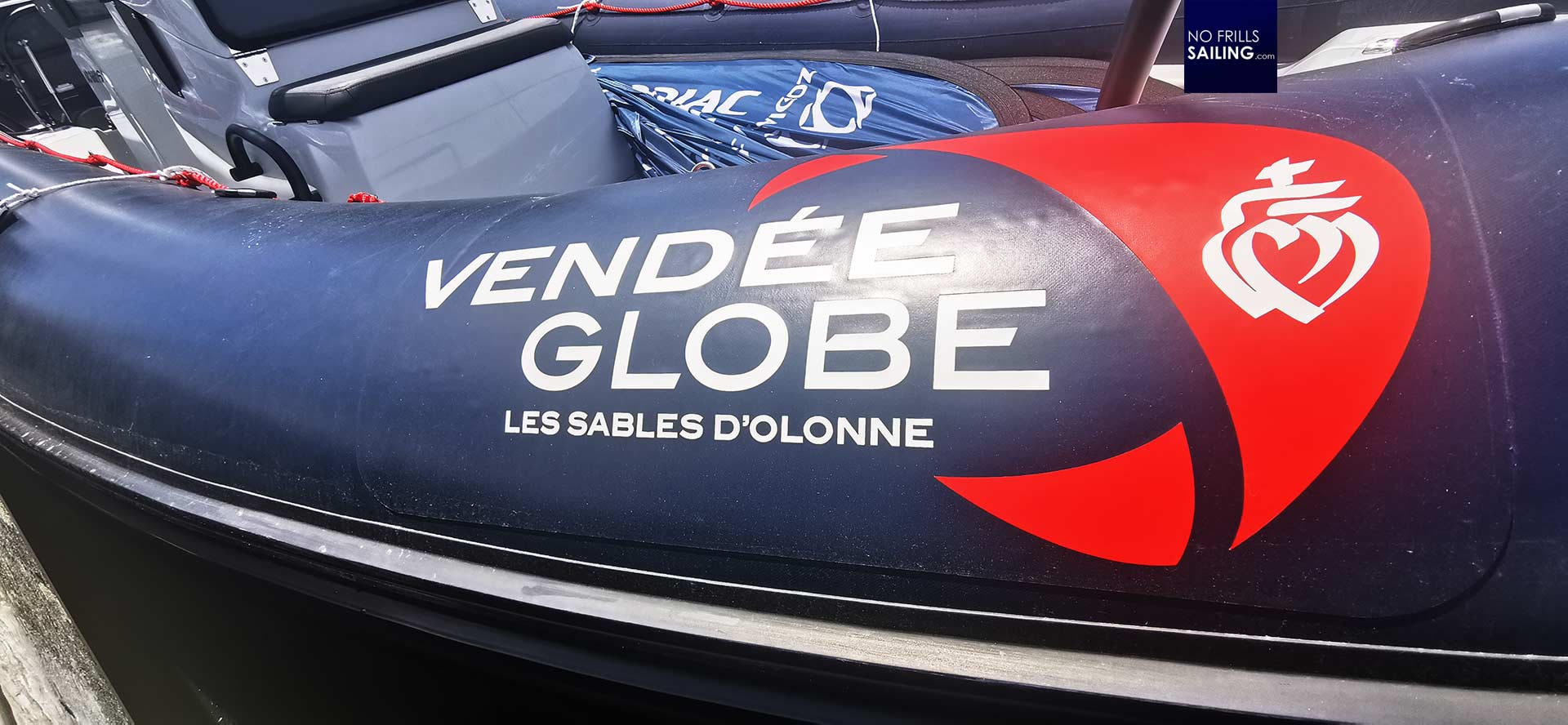
After concluding the two days of dealer meeting in nearby Nantes I went straight to the Atlantic coast to beloved Les Sables d´Olonne where we offered a three day sea trial weekend-event for potential Excess catamaran buyers. Of course, upon arrival, I strolled the pontoons. Not any casual pontoon, but the Vendeé Globe pontoon. Starting in September to the 10th edition, Les Sables d´Olonne will once again turn into the epicenter of sailing. Besides, anytime coming here, you can see something interesting. And so I was happy to not only discover that a familiar Imoca, GUYOT, was moored here, but a new boat as well: GROUPE DUBREUIL.
Welcome aboard GROUPE DUBREUIL Imoca
Well, not so fast! Strolling down the pontoon casually I noticed the shore crew being busily working aboard this beautiful boat. Not wanting to disturb or interrupt, I took some pictures – an occasion to which they are certainly used to, and waited for a good moment to approach them. As it was about four p.m. in the afternoon with knocking-off time approaching, slowly, one by one, left the boat. A loose group of people – technicians, riggers and such – gathered at the pontoon in front of the Imoca. My chance. So I approached them.
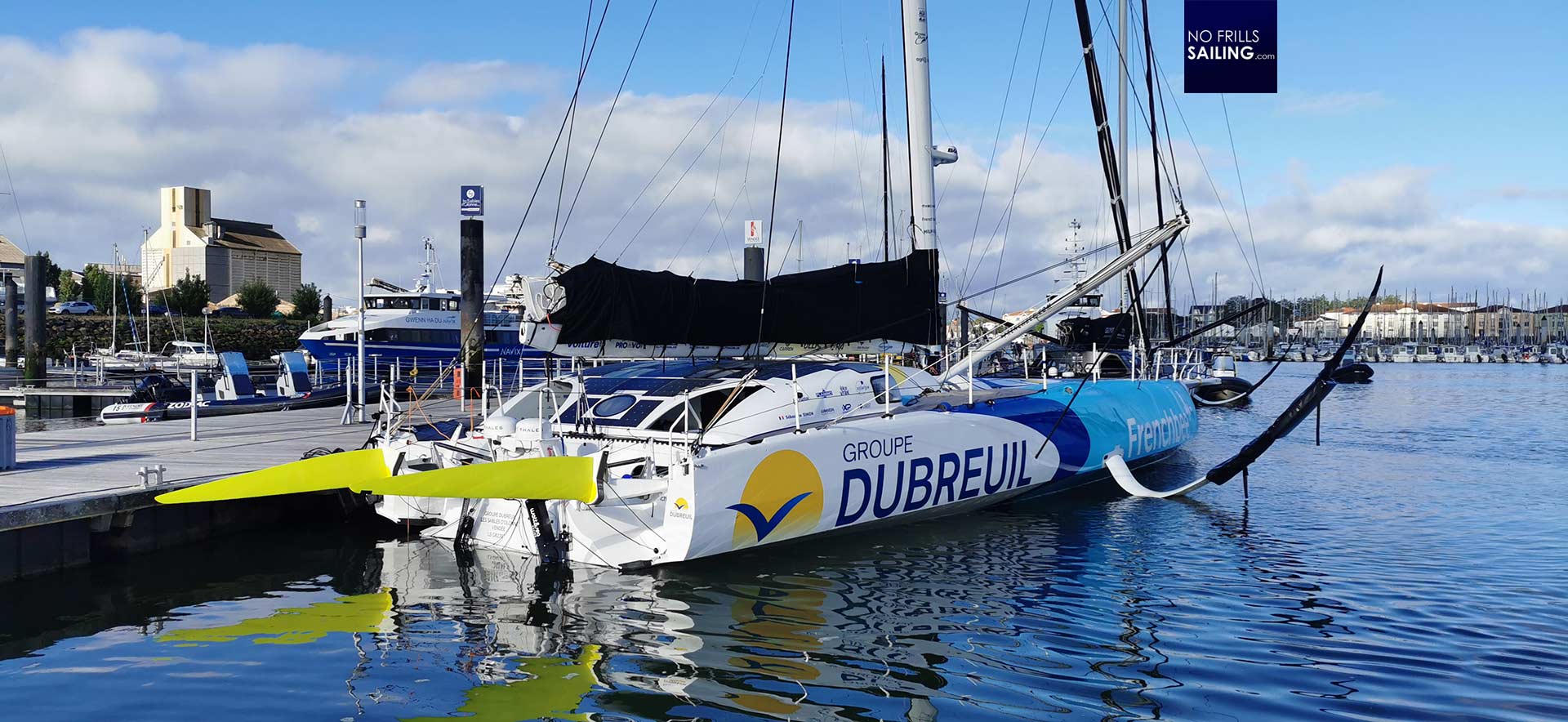
“Hi guys”, I greeted, with them smiling at me, greeting back: “May I talk to the Boat Captain or any responsible guy?” I was hoping that they might say that the owner and Vendeé racer Sebastien Simon would be here, but he wasn’t. Instead the Boat Captain smiled, raised his hand: “What can we do for you?” I introduced myself briefly and declared that it would be my absolute dream to be able to roam an Imoca 60 racing boat from the outside and especially inside to do a complete walkthrough article – maybe one or three, I said, because the internal things like operating the foils, navigational computing and such topics would easily deliver content for many, many articles. If not deemed secret, of course. The Boat Captain smiled: “Sure, no problem! Be here tomorrow at 9 a.m. and we do the room tour, mate.” Yes! Yes! Yes! I thanked the guys, wished a nice after-work and returned to my hotel – so excited! Finally I was going to see an Imoca in all its glory and detail! And so will you, dear readers …
Next morning: On time and heavily excited!
On the next morning I was up early and hurried to haul down two croissants and tasty fresh coffee to be early before time at the boat, neither for love or money I would let go of the chance to finally see “my” Imoca! At exactly 0830, so half an hour early, I arrived. A beautiful, glorious day was about to begin. Sun still up high (approaching summer solistice), still some condensed water on the boat which would be dry in a few minutes. So, what was I about to see? I walked by the boat, starting to take pictures.
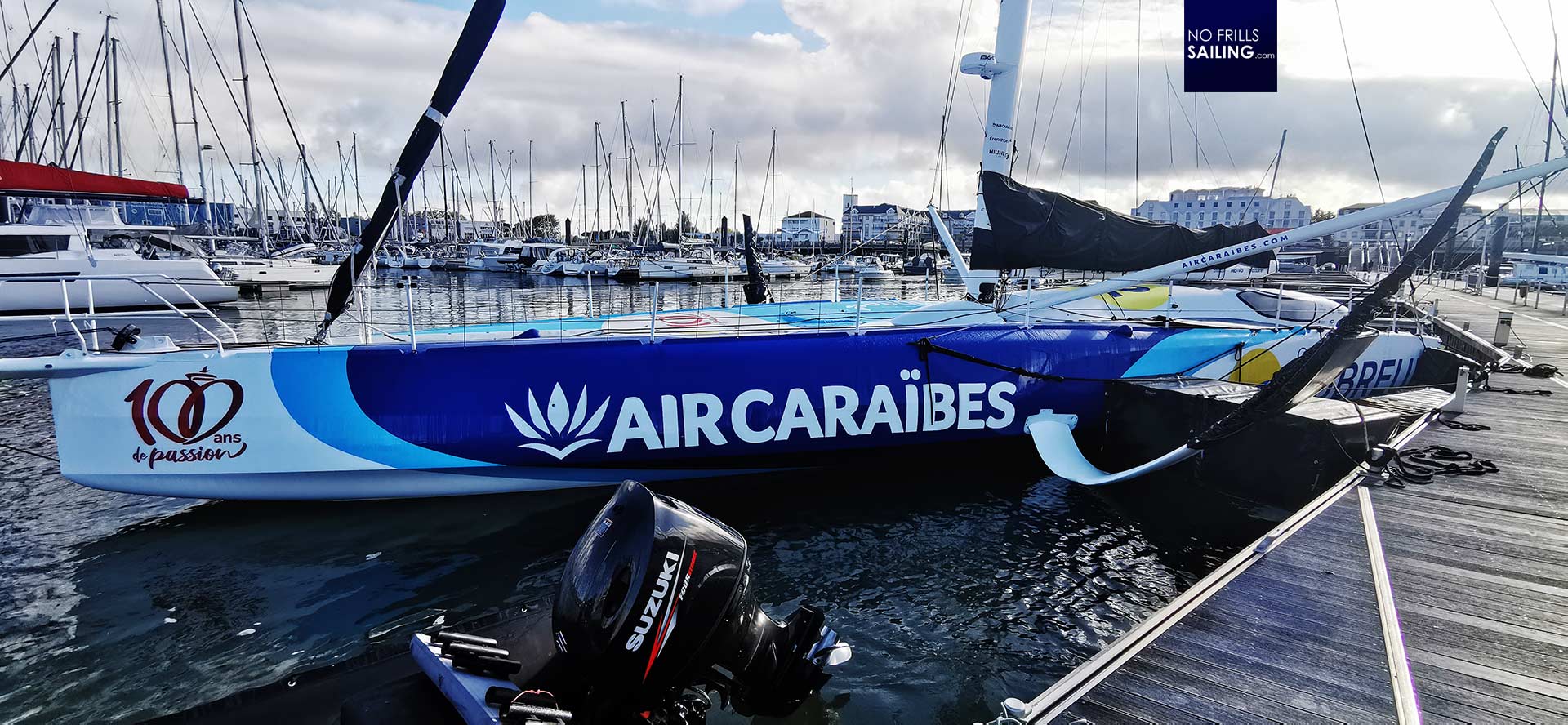
The foils, of course! What defines the modern racing boat construction and especially the world of Imoca-racing was the introduction of the foil. As still the box rule of the Imoca does not allow – stern-foils or foil-assisted draft in the stern section of the boat – the designers have yet to find the best solution to make their boats fly. As of now, an Imoca even in full foiling mode will always crash back onto the water, predominantly with her stern, because there is no equilibrium in stable draft created by just the two huge wings. I was interested in seeing how the foils are operated from the inside and if GROUPE DUBREUIL as well has a sensor-system to measure stress and load on the foils. Such an interesting topic and certainly one of the key features of a modern day Imoca 60 racing yacht.
How does a canting mast actually work?
But there are many more such technical details. Roaming by the boat, I thoroughly checked the rigging. An Imoca 60 has a mighty mast for sure: The rule allows for a mast as tall as 29 meters, which is the actually staggering! Imagine the main sail, which covers 180 square meters, in full canvas up there, the boat slamming into the building waves, having to reef … unimaginable! GROUPE DUBREUIL´s mast has an interesting feature: It can rotate.
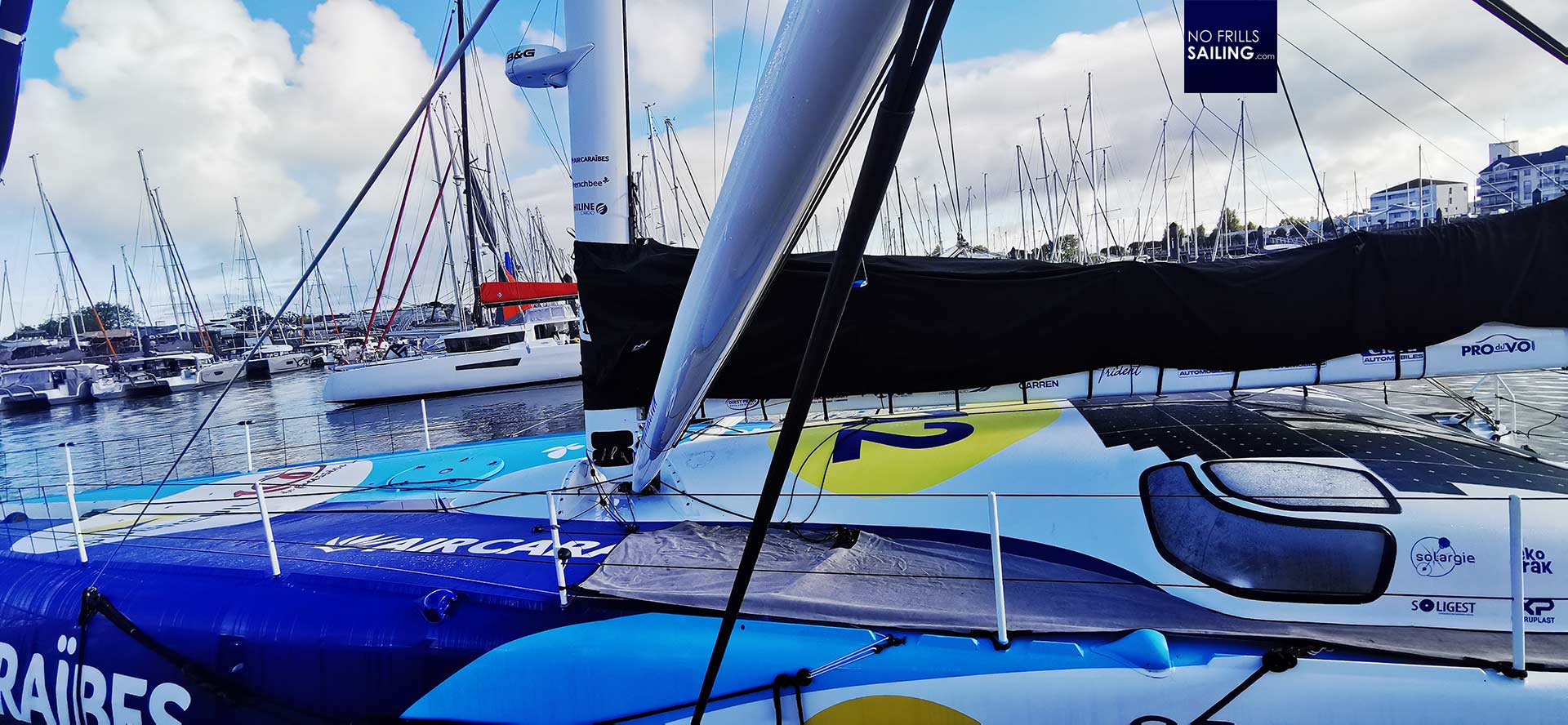
Such a “canting mast” is not a new thing. This technique is around for some decades in sailboat racing now. The idea is that the mast shape itself – being perfectly rounded in the Golden Age of sail – became more and more “streamline”-shaped. Modern mast cross sections resemble an ellipsis which also has something to do with load and stress distribution and the ability to bend backwards, something I got explained very well during my factory tour at Seldén. Now, by canting the mast – meaning to rotate it – the profile of the mast itself becomes part of the sail: Optimizing the air flow onto the sail, minimizing turbulence of swirl at the front of the sail, this technique allows for a much better air flow, hence more speed.
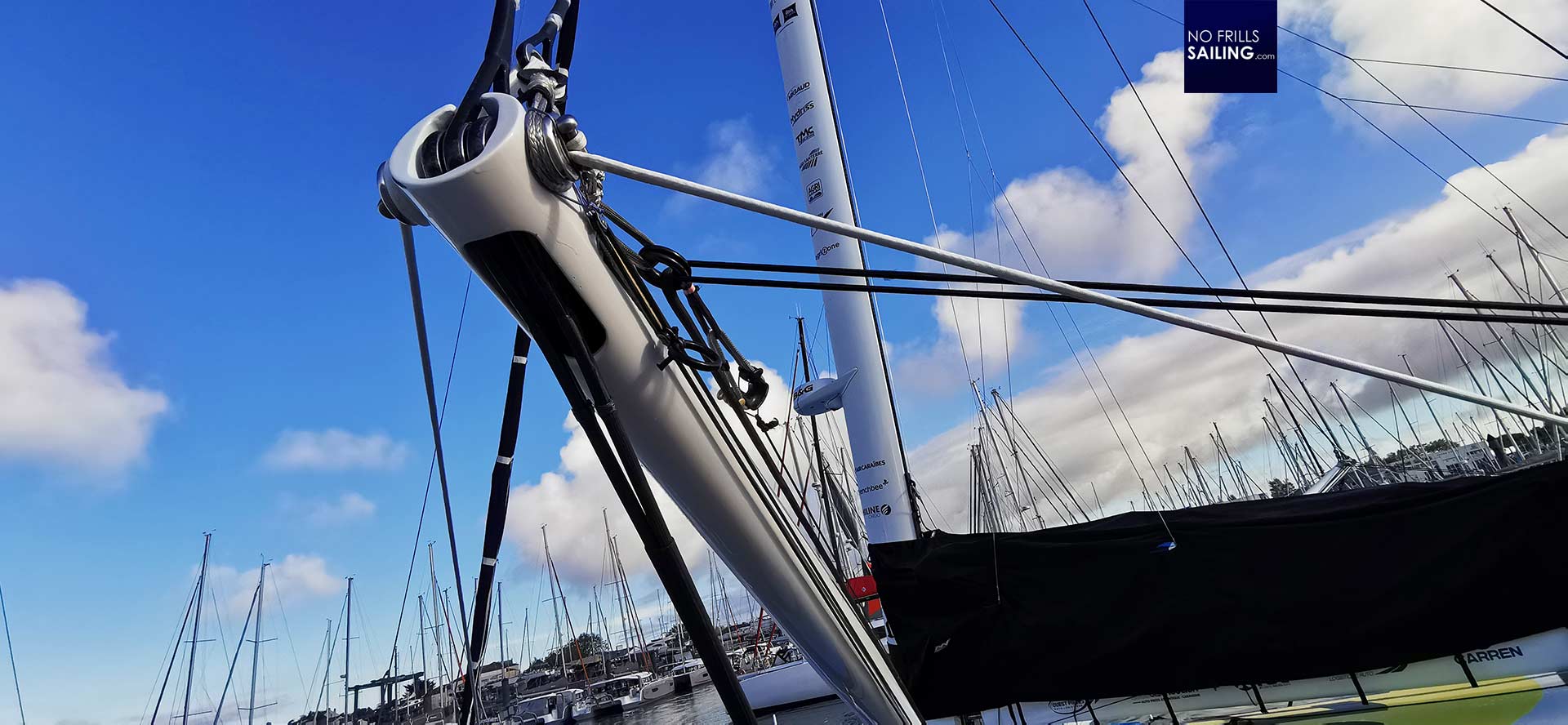
In this, I will finally see how the canting mechanism works, how the angle is measured, how the skipper can measure, find, control and adjust the optimum angle relative to the point of sail he boat is in right at that moment. Thus, by having the mast itself moving, the once standing rigging cannot be as “standing” as it is on regular yachts. So, in addition, I would be able to finally understand the very special setup for the standing rigging of an Imoca racing boat with their huge outriggers. Asolutely amazing! It´s 0845 and still some time before the guys would come …
Steering an Imoca 60
I round the stern section of GROUPE DUBREUIL to take some pre-shots of the rudders. Another specialty of this type of racing machine. The double rudders are masterpieces of composite material production. They have to be absolutely strong and rigid – at last, those boats can reach top speeds of more than 35 knots, which is incredible. Imagine the load on a such a rudder when cutting through the water, changing course against the mass of water it cuts through?! And all this apparently done by such a nimble, thin and fine piece of modern material. Amazing!
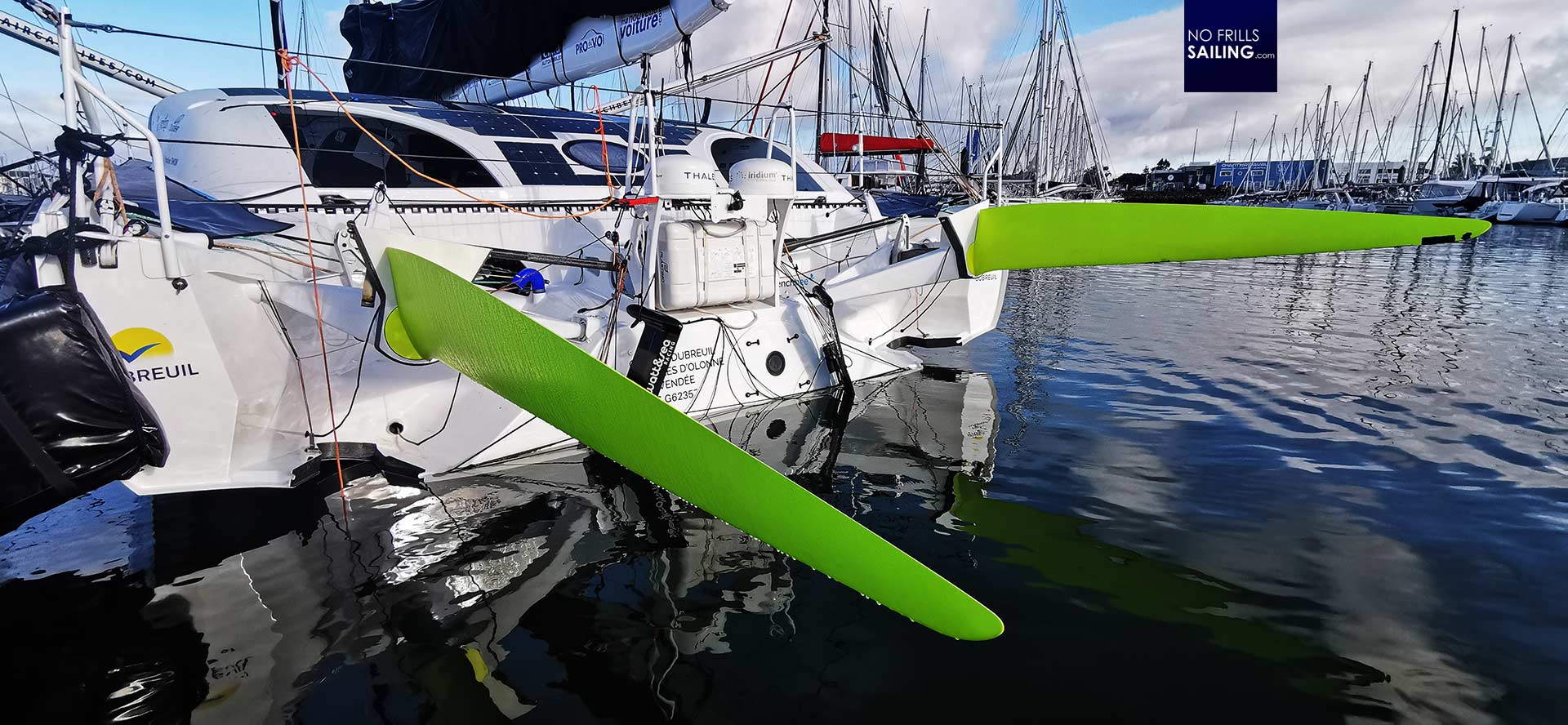
A second detail I am interested to see “from behind the scenes” is the very mechanism of how these rudders are operated. Now, with both blades up, they are simple protected from flotsam and crustation, but later in race mode, depending on the tack the boat is sailing on, usually just the leeward blade is lowered and steering. I can determine the steering mechanism from standing outside very well, but I burn to see it from inside. It´s quite common that Imocas hit something with those blades, so the capability of being able to repair those is key. This is something I will ask the guys and have it shown to me how it works in reality.
A lot of electric energy is needed …
A typical Vendeé Globe-style circumnavigation lasts 70 to 90 days. That´s around the world in top speed through the most hazardous areas our planet´s oceans can offer. This simply can´t be done by steering manually. Usually the advanced auto pilots are engaged right after the start of the race and will not be turned off until Les Sables lighthouse comes into view before the finishing line. Knowing that an auto pilot on a regular cruising yacht is one of the major electric current consumers, I can only imagine the amount of energy that a high-tech pilot and steering system aboard this Imoca 60 will eat up … so, where´s the energy coming from?

This boat, GROUPE DUBREUIL, has a lot of solar panels put on the coach roof of the boat´s “cabin” but also two hydro generators attached to her transom. Maybe there is more technology inside, like a fuel cell (a system which I am actively researching myself for my own new boat as well right now at this moment). I am particularly interested in the energy concept of an Imoca: How much electric power is needed per day and what is the equation behind the whole high-tech equipment? How big is the battery volume? How long can the boat sustain itself in full consumption mode without replenishing the batteries and how is the reload managed? In this, because of the fact that these boats need loads of electricity but have to save on weight so desperately, I see Imoca-racing on the forefront of new marine-approved technology in this sector. 0855, the guys will arrive shortly …
Most interesting: Finally seeing an Imoca 60 from inside!
Peering through the two entrance “holes” at the stern of the boat, of course, my biggest excitement will be to really physically enter the racing boat. I´ve seen the cockpits of many, predominantly older, Imoca 60 back at “La Base” in Lorient already, but I´ve never had the chance to really be in one, let alone in one of the newer boats. GROUPE DUBREUIL has been designed by renowned architect Guillaume Verdier an launched under the name MALAMA just three years ago. Raced by the Eleventh Hour racing team under Charlie Enright, the boat achieved some pretty remarkable results. Like during the Ocean Race 2023 when the oat manages to do incredible 544 miles in 24 hours – crazy!
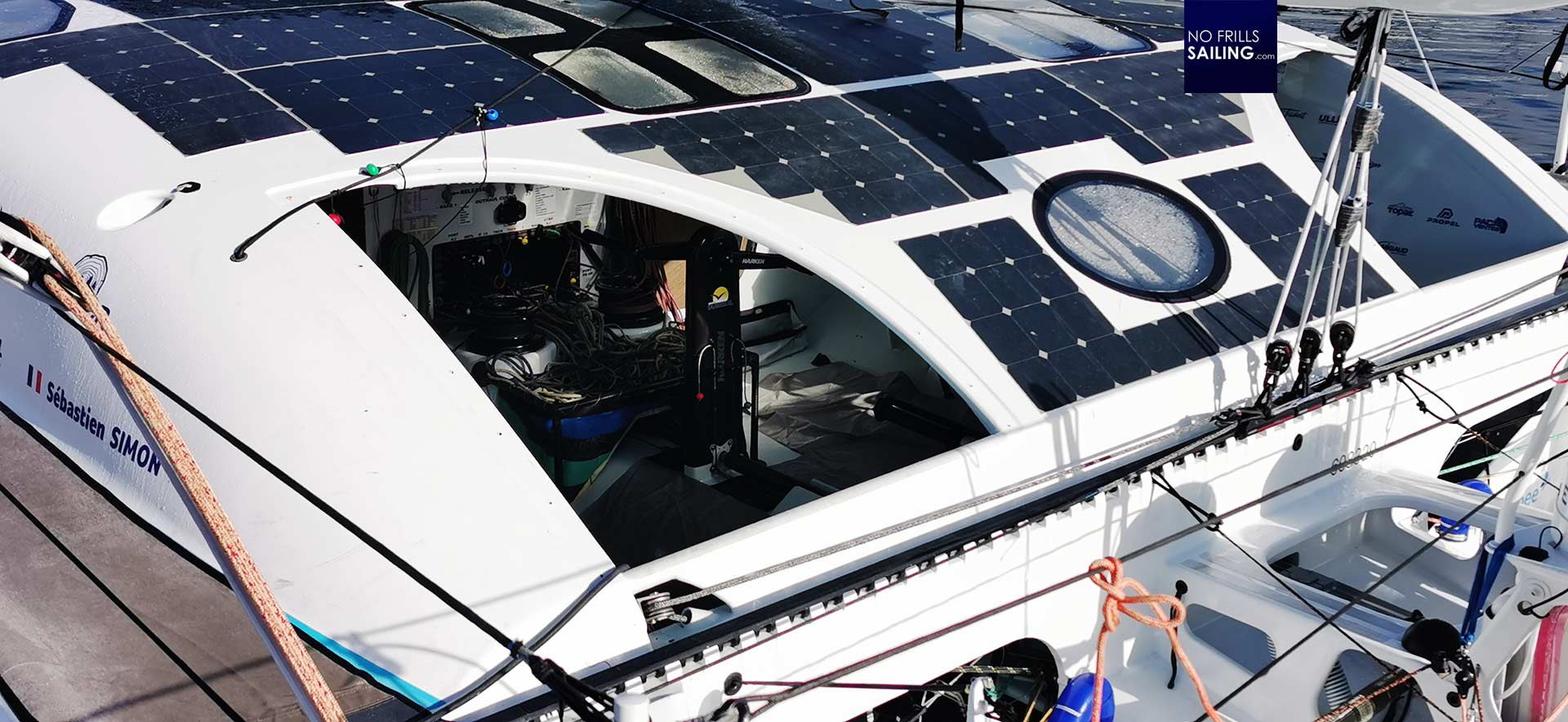
I am particularly interested in the ergonomics of the running rigging. Sailing those new “closed” Imoca yachts means that – in theory – all of those 70 to 90 days during a race like the Vendeé Globe the skipper will never ever leave his protective cockpit. Unless a sail change or repairs are necessary. That means that all standard procedures from hoisting to trimming the sails must be done from inside: I am really keyed up to check the literally dozens of lines, stoppers, winches and grinders inside the wheelhouse of this machine.
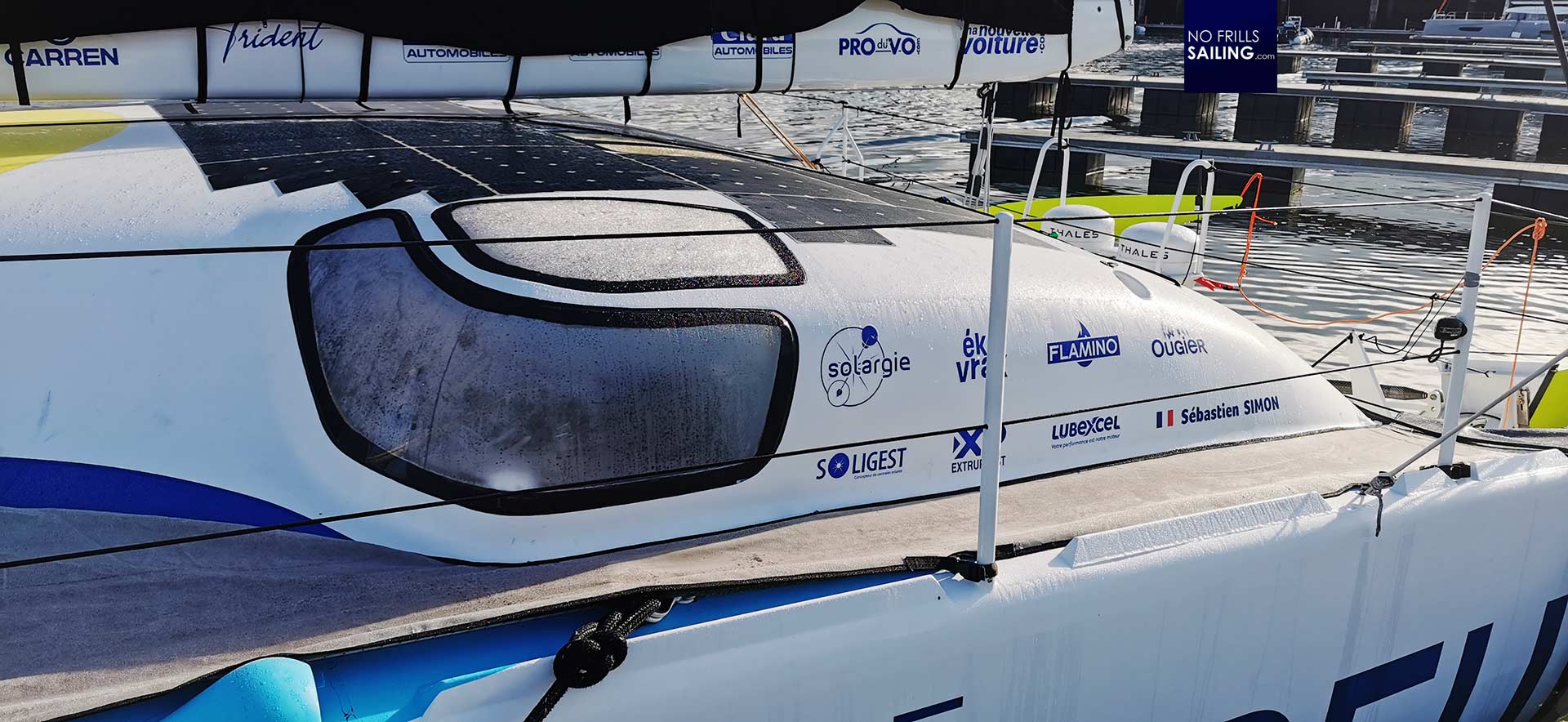
An, of course, to check how “living conditions”, if one could use this word here, down under are set up. Beating along inside a violently rocking boat like this creates not just the noise of a passing freight train but also shocks, moments of perceived zero gravity and heavy, heavy slamming. We´ve all seen the videos of the skippers wearing crash helmets and treating their bruises, cuts and broken limbs due to this roller coaster ride. So, how does an Imoca 60 look like from the inside? Well, it´s 0905 … a bit late, but they must be here in a few minutes I guess.
Well …
I sit there, watch the sun go up and vis-à-vis at the Beneteau-pontoon, my dear colleagues are readying the catamarans for the sea trial event. I wave them, knowing that I will have to be there in less than half an hour to welcome our first guests. As I am a “pro”, I think to myself, I really don´t need the big guided walkaround that takes hours – just and intensive dash into all the exciting details I´ve listed above, a competent Boat Captain should be able to feed me with all the details and insights in 15, maybe 20 minutes. No prob. 0915 … still nobody on the pier.

Well, to be honest, the crew of GROUPE DUBREUIL did not show up. Having my own stuff to prepare I waited until some 20 minutes past 9 and left the scene. Later the day, when we went in an out with our boats, I watched the crew of the Imoca working on their boat. Sadly, my day was fully packed with appointments and another shipyard visit at Excess in the afternoon with me returning not before 7 p.m.. Sadly, my intense walkthrough in an Imoca 60 didn´t happen. Sorry wasting your time, guys, with that article …
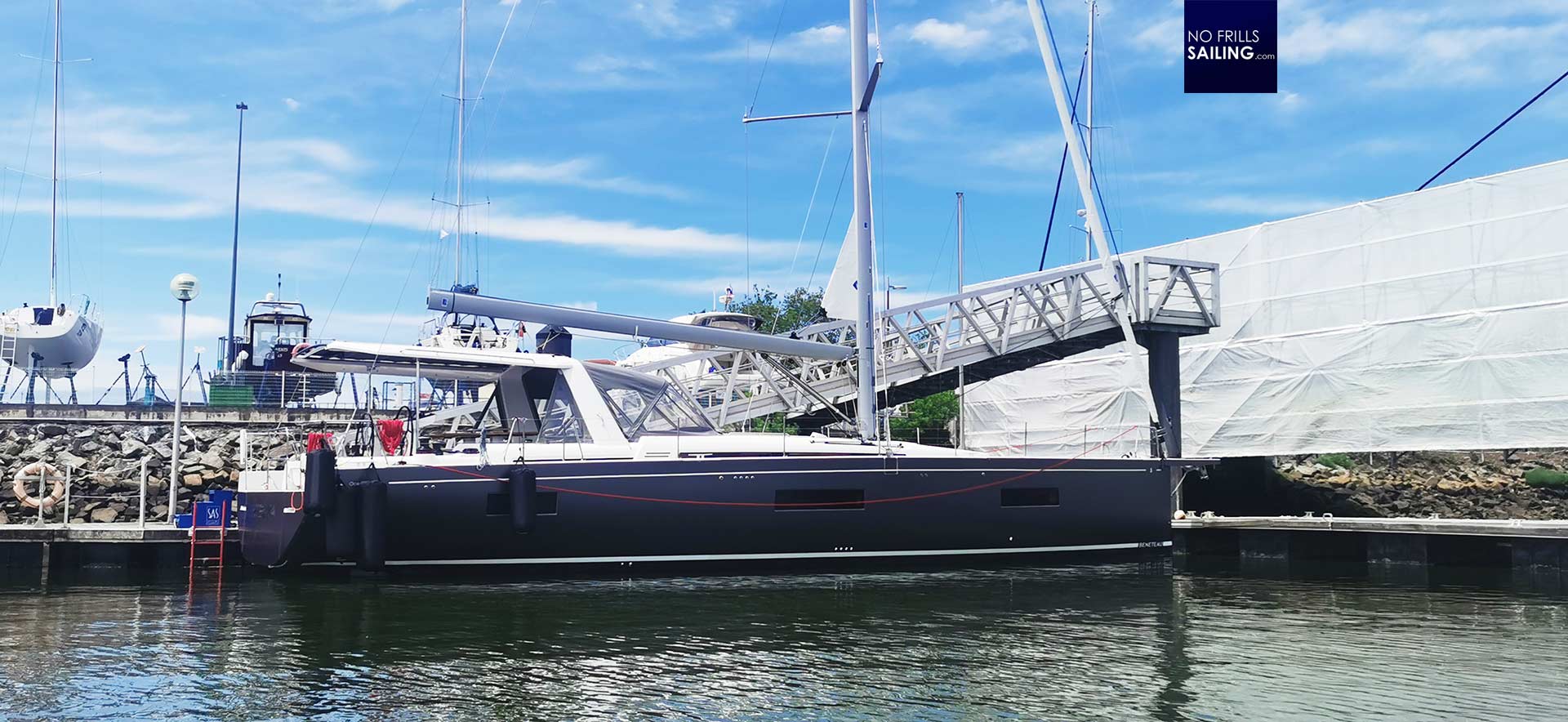
Anyway, as our Oceanis Yacht 60 is currently commissioned and readied at the Beneteau pontoon I will surely come back in one week´s time for handover and shakedown cruise. As this process takes place over three to five days, I will for sure try to get aboard GROUPE DUBREUIL another time. And who knows? Maybe the Boat Captain makes up for the missed date and takes me out for a quick dash … I would!
You may find these connected articles interesting to read:
Sailing an Imoca 60 racing yacht for the first time
Charal 2 vs. Malizia 3: At Lorient´s “La Base”
Carbon Fibers don´t like slamming: About the limits of modern Imoca-racing
